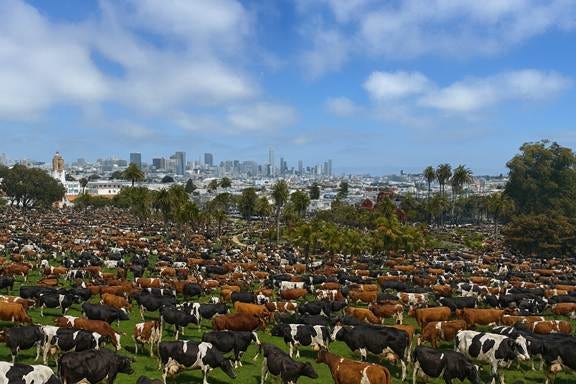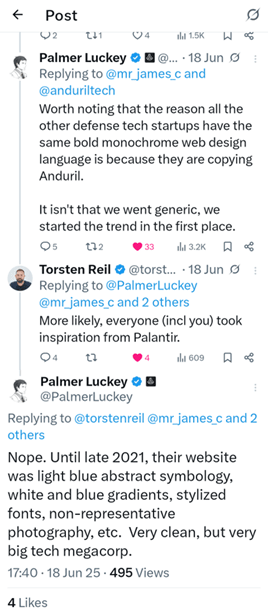In 1833, the British economist William Forster Lloyd described what we now know as The Tragedy of the Commons a shared resource gradually degraded by individuals acting rationally in their own interest. The cows get fed. The pasture gets ruined.
Attention Grazing
It’s a useful analogy for consumer attention. Because in category after category, from fintech to defence, wellness to AI tools, marketing is eating itself.
It begins innocently enough. A few breakout brands land with clarity and confidence that look and sound different. They communicate a point of view and people take notice, investors bookmark them. Agencies reference them in pitch decks. Startups copy them… first loosely, then shamelessly.
What began as distinctiveness becomes direction. Then formula. Then cliché.
Before long, every company in the category has the same logo structure, the same palette, the same tone of voice, which depending on your category could be anything from reassuring-but-slightly-ironic (consumer finance) to Sun Tzu meets GenZ Gundo Bro (Defence). Everyone’s empowering or redefining or making [X] more accessible. Everyone is optimising the same layouts and testing the same buttons.
But no one is really saying anything.
The Challenge for Startups
If you're a founder, marketer, or investor reading this, you already know what I’m talking about. You've seen the websites and sat through the decks. Glimpsed five logos on a VC landscape slide and realised you can’t recall which is which. That’s the cost of convergence. Not just creative fatigue but strategic erosion.
And it’s not a coincidence. There are reasons this happens, and they’re often structural. While I have evert respect for my performance marketing colleagues, their optimization efforts are driving this dynamic: A/B testing, Figma and Canva templates, and ubiquitous AI executions that drive engagement while circling the same spot.
In a previous post I talked about how this impacts defence startups:
“When it comes to brand fonts and colourways, both Anduril and Helsing have adopted the ubiquitous (and IMO very boring) “Defence Dun” font, colour and language combo for their brands. It’s something you see again and again with defence brands. It’s dull, but seems to be nearly industry wide - go to any random defence company website (like this, this, this, or this and you get either beige, off-white, cream, ivory or black). And so it is with Anduril and Helsing. As you can see from these website screengrabs, you could swap either brand around with little effort. So far, so dull.”
As it turned out, this caused some debate:
But it’s common across many sectors and it’s going to get a whole lot worse with new AI tools.
Slop and Sloptimisation
Generative AI tools are trained on what already exists. So unless you push them hard, they’ll default to the middle. And when everyone’s briefing the same tools with the same inputs and the same cultural references, the outputs get increasingly predictable. Even if a new ‘format’ is discovered, it is quickly copied.
There’s a reason why much of the new Google Veo films are in the format “protagonist selfie” – like this, and this, this, this, this and also that. Ultimately because that’s how most influencer footage is done already. Yes there are efficiencies but you’re increasingly levels of slop and ultimately driving consolidation.
Which would be fine if the goal of brand building was “median competence”. But it isn’t. Or at least, it didn’t used to be.
It’s worth pausing to consider what all this uniformity actually signals.
To customers? It suggests you’re part of a class of interchangeable companies with no real edge.
To talent? That your culture might be about as original as your tagline.
To investors? That you’re following, not leading.
To everyone else? Maybe that Silicon Valley series had it right after all?
And if you zoom out, you start to see something bigger. A degraded marketing commons, one where the signals that used to help customers make choices are now muffled under a layer of aesthetic homogeneity and borrowed language. No one wants to be the one who breaks pattern because pattern is what our optimisation machine selects for.
Seeking Pastures New
But we’re not the first to discover this problem, it’s one that markers have tackled decade after decade in category after category. Yes, that’s right, the ancients (those of us in marketing born before the 1980s) found ways to solve the problem. In the following post I’ll talk about how creative risks are essential for successful brands in busy categories.
Because as it turns out, risk is essential to building great brands and to feeding cattle, ultimately both involve finding new pastures.
Lookout for my next post which will celebrate creative risk taking and how it helps businesses create great brands.





